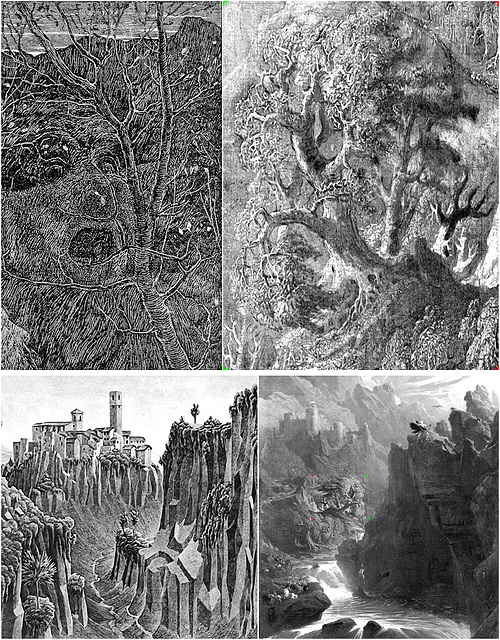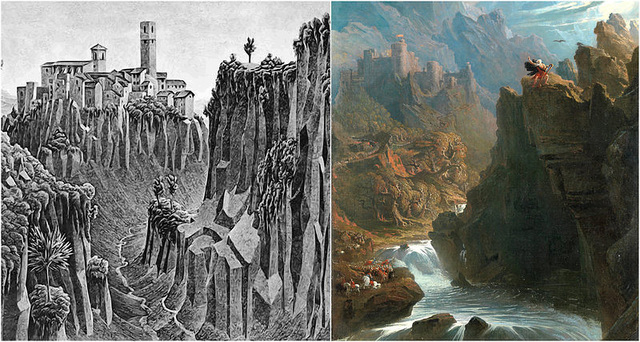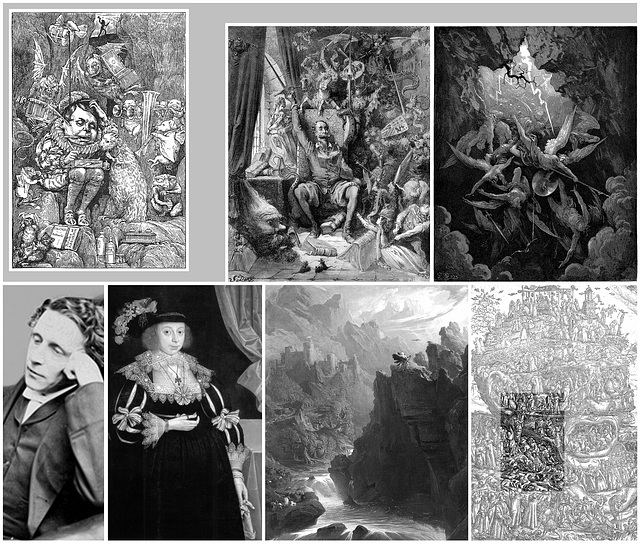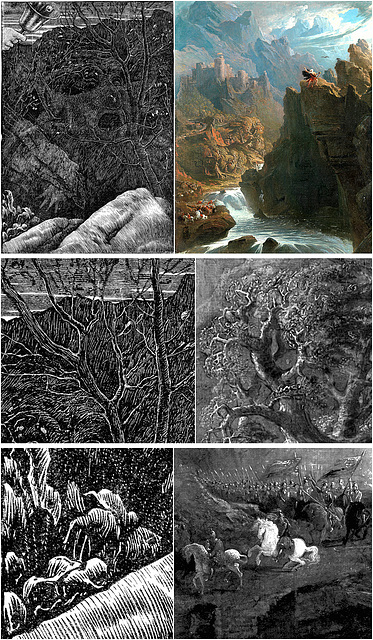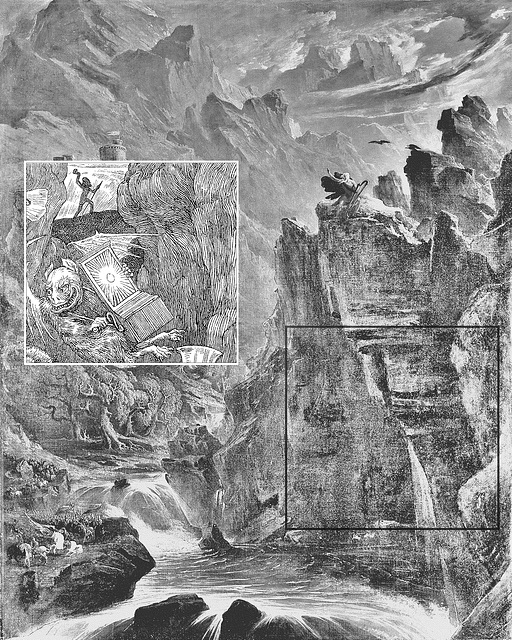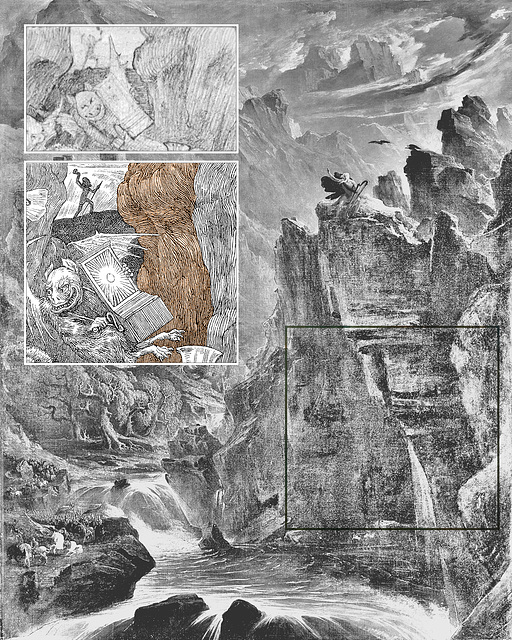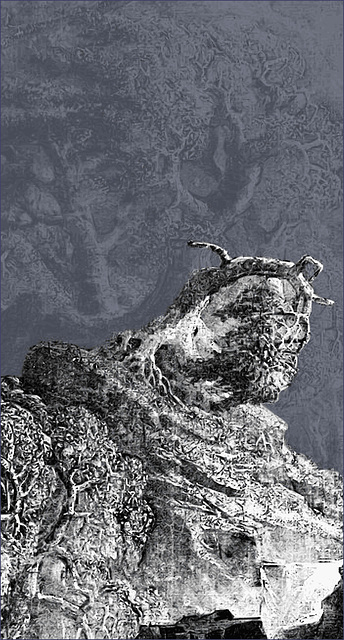
John Martin
Folder: The Hunting of the Snark
See also: Henry Holiday's Snark illustrations and John Martin's "The Bard":
- www.academia.edu/9885417/The_Bellman_and_the_Bard
- www.academia.edu/9923718/Henry_Holidays_Monsterspotting
- www.academia.edu/10251338/Monsters_and_Monstrances
- www.academia.edu/12586460/The_Bard_the_Baker_and_the_Butcher
- www.academia.edu/9885417/The_Bellman_and_the_Bard
- www.academia.edu/9923718/Henry_Holidays_Monsterspotting
- www.academia.edu/10251338/Monsters_and_Monstrances
- www.academia.edu/12586460/The_Bard_the_Baker_and_the_Butcher
30 May 2013
2 comments
Henry Holiday's and M.C. Escher's allusions to John Martin
[top left]: Detail of an illustration by Henry Holiday to Lewis Carroll's "The Hunting of the Snark" (1876)
[top right]: Mirror view of a horizontally compressed detail from John Martin's "The Bard" (ca. 1817, see red and green marks below)
[bottom left]: M.C. Escher: Cimino Barbarano, 1929
(middle segment, redrawn from original, horizontally compressed)
See also: www.mcescher.com/Gallery/ital-bmp/LW129.jpg
[bottom right]: John Martin: The Bard
ca. 1817
(Color desaturated segment)
Original painting: Yale Center for British Art, Paul Mellon Collection
collections.britishart.yale.edu/vufind/Record/1671616
M. C. Escher took the whole concept of John Martin's The Bard . Henry Holiday in most cases quoted different elements (shapes) in his source images and often gave those elements a completely new meaning. (In one case the shapes even were the cracks in the varnish of a source image.)
=== John Martin: The Bard ===
Yale Center for British Art: "Based on a Thomas Gray poem, inspired by a Welsh tradition that said that Edward I had put to death any bards he found, to extinguish Welsh culture; the poem depicts the escape of a single bard. Escher turned that landscape into am Italian scenery."
In mydailyartdisplay.wordpress.com/the-bard-by-john-martin , "Jonathan" connects the painting to the poem The Bard written by by Thomas Gray in 1755:
· · ...
· · On a rock, whose haughty brow
· · Frowns o'er cold Conway's foaming flood,
· · Robed in the sable garb of woe
· · With haggard eyes the Poet stood;
· · ...
· · "Enough for me: with joy I see
· · The diff'rent doom our fates assign.
· · Be thine Despair and sceptred Care;
· · To triumph and to die are mine."
· · He spoke, and headlong from the mountain's height
· · Deep in the roaring tide he plunged to endless night.
· · ...
The poem and the painting may have been an inspiration to Lewis Carroll and Henry Holiday in The Hunting of the Snark:
· · 545 · · Erect and sublime, for one moment of time.
· · 546· · · · In the next, that wild figure they saw
· · 547· · (As if stung by a spasm) plunge into a chasm,
· · 548· · · · While they waited and listened in awe.
09 Feb 2013
1 favorite
3 comments
M. C. Escher's allusion to John Martin's "The Bard"
www.flickr.com/photos/bonnetmaker/8460032132
This discovery is a kind of "bycatch" from my Snark hunt: M. C. Escher's "Italian" scene shown above (left side) is not a copy like his version (1935) of a segment from a paintig by Hieronymus Bosch. The scene is a more subtile allusion to John Martin's The Bard .
Segments:
[left] Maurits Cornelis Escher: Cimino Barbarano , 1929 (in Escher's "Italian" period )
[right] John Martin: The Bard , ca. 1817
For this side-by-side comparison, I redrew and then horizontally compressed Escher's lithograph after applying selective Gaussian filtering to the image in order to remove details which are not required for the comparison. Parts of the image on its sides have been removed. The top of Martin's painting has been removed too.
Earlier I thought that Escher here perhaps has combined an Italian scenery like Civita di Bagnoregio with what may be supposed to be a (Cambrian?) landscape, as it was there where Edward I went after the Welsh bards. But the landscape is not "Cambrian":
www.socialhistoryofart.com/19thCentury/ ... /John Martin.doc
"Ignoring the Welsh highlands, Martin clearly modeled his landscape on the Swiss Alps which had recently emerged as a major destination for English travelers thanks to the Romantic Alpine poems of Byron and Shelley, among others, and the Alpine landscapes of Koch and Turner. Spurning the tranquil and majestic “Alpine sublime” developed by Koch, Martin took the more dramatic Alpine compositions of Turner and transformed them with his own, quasi-Apocalyptic fervor. In so doing, he gave Alpine landscape the emotional turmoil found in Blake and Byron. And in all this, he took Gray’s Bard into completely new territory, leaving behind all traces of eighteenth-century restraint, decorum, reason, and quiet morality."
Robert Baldwin , 2010
The © for this image applies to the presentation of the discovery of the relation between Escher's print and Martin's painting. Escher's original illustration is © Cordon Art B.V. - Baarn - Netherlands.
See also: flipsideflorida.wordpress.com/2013/03/06/escher-the-bard
19 Jul 2013
6 comments
6 Sources to the Beaver's Lesson
Henry Holiday, Gustave Doré (2x) ,
Lewis Carroll (mirror view), Marcus Gheeraerts the Younger (mirror view), John Martin , Marcus Gheeraerts the Elder
(I am not so sure about Henry Holiday's allusion to the image on the lower right side by Marcus Gheeraerts the Elder.)
09 Dec 2012
2 comments
Henry Holiday alluding to John Martin
[left]: Henry Holiday: Illustration (1876) to chapter The Vanishing in Lewis Carroll's The Hunting of the Snark
[right]: John Martin: The Bard (ca. 1817), now in the Yale Center for British Art
26 Nov 2013
1 favorite
6 comments
Bellman & Bard after retinex filtering
[main image]: John Martin: The Bard (ca. 1817) , by GIMP: contrast enhanced in the rock area & light areas delated & (most of) color removed & retinex filtering
[inset]: Henry Holiday: Illustration (1876) to chapter The Beaver's Lesson in Lewis Carroll's The Hunting of the Snark , detail
In mydailyartdisplay.wordpress.com/the-bard-by-john-martin , "Jonathan" connects the painting to the poem The Bard written by by Thomas Gray in 1755. Inspired by a Welsh tradition that said that Edward I had put to death any bards he found, to extinguish Welsh culture; the poem depicts the escape of a single bard:
· · ...
· · On a rock, whose haughty brow
· · Frowns o'er cold Conway's foaming flood,
· · Robed in the sable garb of woe
· · With haggard eyes the Poet stood;
· · ...
· · A Voice, as of the Cherub-Choir,
· · Gales from blooming Eden bear;
· · And distant warblings lessen on my ear,
· · That lost in long futurity expire.
· · Fond impious Man, think'st thou, yon sanguine cloud,
· · Rais'd by thy breath, has quench'd the Orb of day?
· · To-morrow he repairs the golden flood,
· · And warms the nations with redoubled ray.
· · "Enough for me: With joy I see
· · The different doom our Fates assign.
· · Be thine Despair, and scept'red Care,
· · To triumph, and to die, are mine."
· · He spoke, and headlong from the mountain's height
· · Deep in the roaring tide he plung'd to endless night.
· · ...
Full text:
www.thomasgray.org/cgi-bin/display.cgi?text=bapo
spenserians.cath.vt.edu/TextRecord.php?action=GET&tex...
www.english.upenn.edu/~mgamer/Etexts/gray.bard.html
www.google.com/search?q="A+Voice,+as+of+the+Cherub-Choir"
The poem and the painting may have been an inspiration to Lewis Carroll and Henry Holiday in The Hunting of the Snark . This is about The Vanishing of The Baker :
· · 537 · · "There is Thingumbob shouting!" the Bellman said,
· · 538 · · · · "He is shouting like mad, only hark!
· · 539 · · He is waving his hands, he is wagging his head,
· · 540 · · · · He has certainly found a Snark!"
· · 541 · · They gazed in delight, while the Butcher exclaimed
· · 542 · · · · "He was always a desperate wag!"
· · 543 · · They beheld him--their Baker--their hero unnamed--
· · 544 · · · · On the top of a neighbouring crag.
· · 545 · · Erect and sublime, for one moment of time.
· · 546 · · · · In the next, that wild figure they saw
· · 547 · · (As if stung by a spasm) plunge into a chasm,
· · 548 · · · · While they waited and listened in awe.
Album:
John Martin
06 Dec 2013
2 comments
Bellman & Bard for B&W printing
Dithered B&W version for printing:
Width: 101.6 mm (2400 pixels),
Height: 127 mm (3000 pixels),
Resolution: 23.6220 pixels/mm (600 pixels/in).
[main image]: John Martin: The Bard (ca. 1817) , by GIMP: contrast enhanced in the rock area & light areas delated & color removed & Retinex filtering
[inset]: Henry Holiday: Illustration (1876) to chapter The Beaver's Lesson in Lewis Carroll's The Hunting of the Snark , detail
I also copied this to commons.wikimedia.org/wiki/File:The_Bellman_and_the_Bard.png .
21 Sep 2014
4 comments
Fun with Allusions
I think that Henry Holiday had quite some fun in imagining how the beholders of his illustrations would deal with what they might see. And the cannot hold him responsible for what they see.
Jump to top
RSS feed- Latest items - Subscribe to the latest items added to this album
- ipernity © 2007-2025
- Help & Contact
|
Club news
|
About ipernity
|
History |
ipernity Club & Prices |
Guide of good conduct
Donate | Group guidelines | Privacy policy | Terms of use | Statutes | In memoria -
Facebook
Twitter

